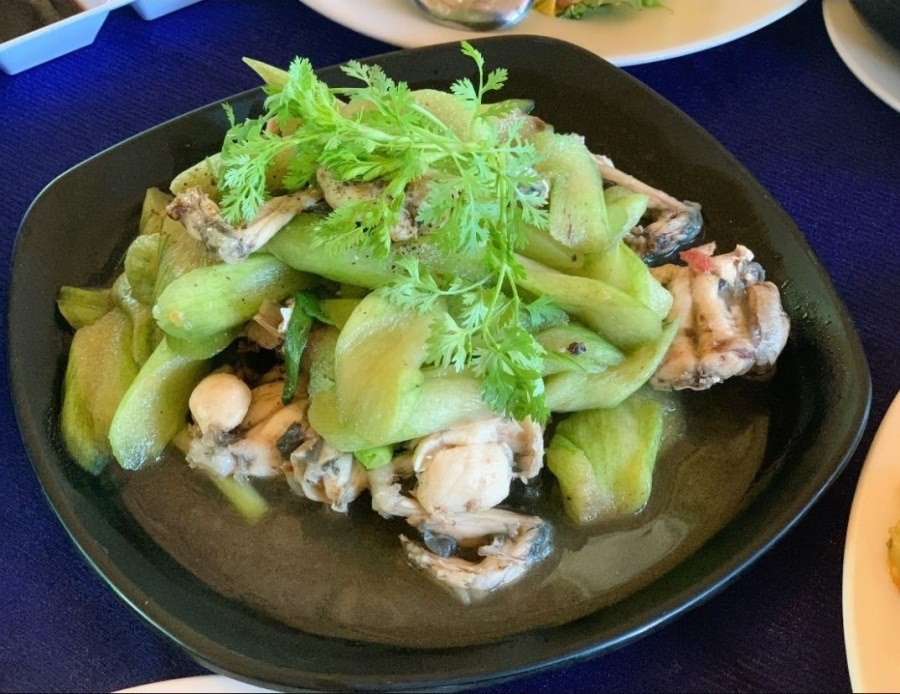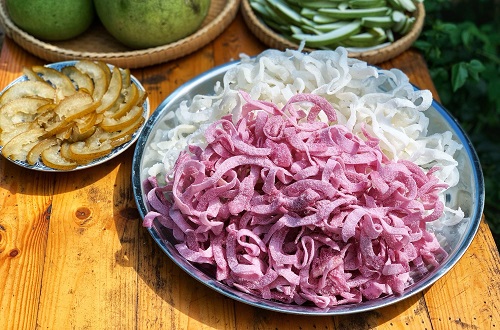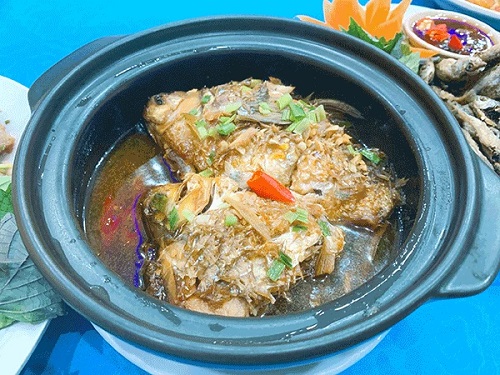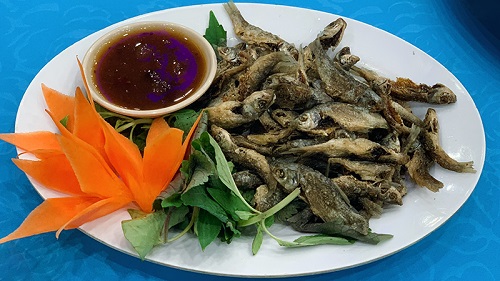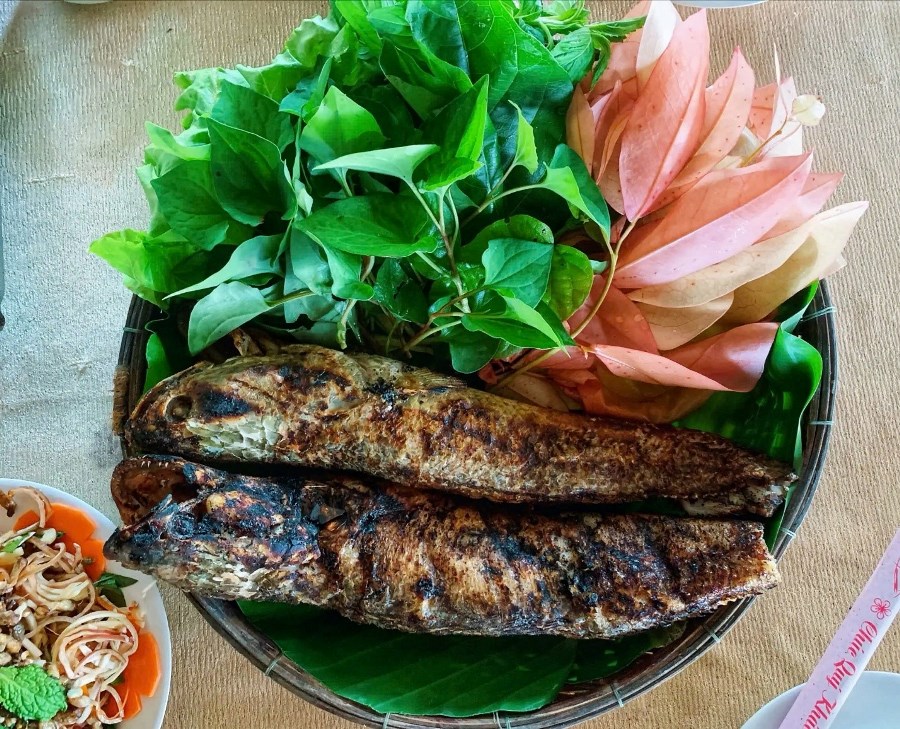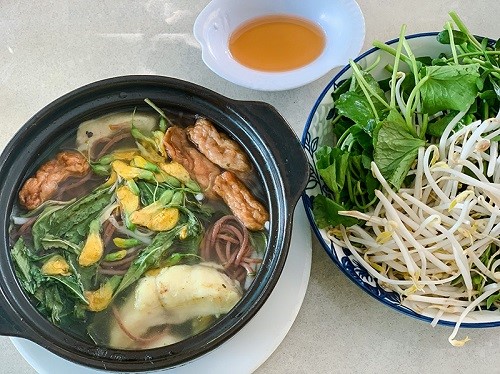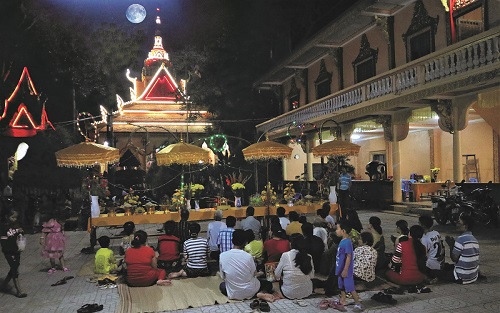
Ok-Om-Bok
Ok-Om-Bok festival, also known as the moon worshiping ceremony or the water-giving ceremony of the Khmer people, consists of two parts:
The Ngo boat racing festival (Um-tuk) is held at noon on the 15th day of the 10th lunar month every year. The Ngo boat is a special type of boat with a long snake-like shape, curved top, and tail, no roof, 22-24m in length, with about 20-24 compartments. The width of the boat is about 8 socks, just enough for 2 rowers to sit, the whole boat has about 43-52 rowers. The Ngo boat is made of an intact, hollow merawan tree trunk in the style of a canoe. The Ngo boat is the boat of a pagoda and is considered a sacred object used only for the annual boat race. The Ngo boat is carefully stored in the temple, in a tall, airy house called "Rong-tuk". According to the Khmer, each Ngo boat has a guardian deity..
About a month before the boat racing festival, the temple's eldest monk will launch a Ngo boat ceremony. The eldest monk will choose the number of healthy young men in the phum and soc (village, hamlets) to be the rowers. These rowers must stay in the temple and undergo a pure vegetarian diet, and cannot return to their families for a month of practice.
Before the opening time of the Ngo boat race, on both sides of the river, many people gathered to watch the festival. Every year, about 300-500 thousand people of all ethnic groups, Vietnamese, Chinese and Khmer come to see the festival. While waiting to watch the boat race, people participate in folk games: kickball, fly kites, push trees, enjoy the rustic dishes of the Khmer people.
The boat race starts at about 11:00 - 12:00 at noon, every year there are about 20 - 40 boats participating. The race is conducted on a river section of about 3 to 5km, divided into three steps: elimination, final, and classification.
At about 4-5 pm, the race ended, everyone returned to phum, soc to prepare for the moon worshiping ceremony.
The moon worshiping ceremony, or Ok - om - bok ceremony, is conducted as follows: On the night of October 15 of the lunar calendar, before the moon rises to the top, everyone gathers in the temple grounds, in the courtyards or many families come together to a spacious place without the shadow of trees to do the ceremony.
First, they dig a hole to plug two bamboo trees (in some places they make two sugar canes tied together) into a gate, decorated with flowers and leaves. Under the gate, there is a table of offerings, first of all, flattened rice and some other agricultural products: bananas, potatoes, coconuts.... Then they spread out mats inviting everyone to sit facing the moon and invited an Acha to preside over the ceremony.
People make offerings of incense, tea, and Acha on behalf of everyone, praying for the gods to receive the gifts, bless everyone, the next season, the weather will be favorable so that everyone has a bountiful harvest.
After the worshiping ceremony, Acha called the children to kneel with their hands folded towards the moon, then put flattened rice in their mouths, lightly punch them on the back, and ask them what they wish for. The children's answers will be believed by adults as good or bad predictions for the next crop.
After the above rituals, everyone eats offerings, talks, dances, and sings, and the children play until late, then the ceremony ends.
In the traditional Ok-om-bok festival, multi-layered culture (also called integrity) is a very unique feature. Multi-layeredness is the simultaneous expression of relationships in a cultural phenomenon: the multi-layer of social consciousness, different beliefs and religions, the combination of culture with the practical activities of people's life......
MULTI-LAYERED CULTURAL FEATURE
The Ngo boat racing festival, first of all, is a vestige of the mascot-worshiping custom from the primitive times of the agricultural inhabitants of Southeast Asia. Khmer people have the custom of worshiping crocodiles and water snakes. The Vietnamese have a custom of worshiping a serpent-like monster, which is later deified into the image of a dragon, one of the four spirits even of the Chinese. On the other hand, the Ngo boat race is also a ritual to send off the water god, the rain god of the Khmer people in the lower Mekong region. Later, due to the cultural influence of India, Brahmanism, and Buddhism, the Khmer explained the Ngo boat racing festival with many different legends.
According to the Rig - Veda, one of the four great legends of India, the god Visnu - the guardian god who rides the giant bird Garuda is the king of birds who have enmity with snakes represented by Naga snakes. Garuda often captures mermaids and snake fairies.
This legend reflects the conflict between two primitive tribes of India. The hunting tribe has the totem of bird Garuda and the fishing tribe has the totem of water snake Naga. The Ngo boat, which simulates the shape of the Naga, was ridden by humans and submitted to them.
According to another legend, the Ngo boat race began to appear in the 13th century. After the Kingdom of Cambodia built the temple of Angkor - wat, the new king organized an annual boat race to show the martial spirit of the soldiers on the river.
Ngo boat racing festival is also imbued with the philosophy of Buddhism. It is said that the people organize a boat race to commemorate the traces left by the Buddha on the sand bank of the Nimota River in Yônol (Laos). Ngo boat racing is also to remember a boat bridge built by Buddha to prevent a great drought in Vaicali kingdom or to remember a tooth of Buddha kept by the king of snakes Naga.
The Ngo boat racing festival, according to the Khmer, is also associated with a legend related to monks and temples. Once upon a time, one day at noon the monks left the temple for alms. When they left, suddenly met with heavy rain, strong wind, around the temple was flooded with immense water. People in the area wanted to bring the monks back to the temple, so they cut down trees to build boats and rafts to carry them. The water is getting bigger and bigger, the work of making boats becomes urgent. Those who can build boats and rafts quickly and carry many monks to the temple will be greatly blessed.
Many people participated, the number of boats increased and turned into a festival on the river to this day.
Also according to the Khmer, Ngo boat racing is also to thank the land and the country for the favors and gifts given to people. And this is also an opportunity for people to apologize for dirtying the Land - Water.
For the moon worshiping ceremony and the feeding of flattened rice to children, it is also traced back to the rituals, folk beliefs and the sense of nature of the agricultural residents. The Khmer do farming in two seasons of the year in the South. The rainy season is from April 16 to October 15 of the lunar calendar and the dry season is from October 16 to April 15 of the next lunar year. Those two seasons are calculated according to the earth's rotation of the moon. Therefore, the 15th day of the 10th lunar month is the last day of summer and also the time to harvest crops. Among the crops, sticky rice is the earliest. People use early sticky rice to pound into flattened rice and some other agricultural products to make offerings to the moon.
The moon is originally a god who controls the crops of the year. Feeding flattened rice to children is also to convey their aspirations for the next crop, for the future, and to pray for prosperity.
However, the Khmer explain the origin of this ritual with a story that bears both traces of Buddhism and is the motif of a folk tale. If in Vietnamese, the shape of the moon is associated with the banyan tree, the cuoi, with Lady Hang Nga, the Khmer think that the moon is the shape of a white rabbit. The rabbit on the moon is the past life of Buddha Shakyamuni.
Rabbits live around the banks of the Ganges and make friends with monkeys, otters, and jackals. Rabbit knows more than the other 3 animals, and knows how to meditate to pray to be close to the great beings. Years passed, the day before the full moon, the rabbit advised his friends to meditate to keep their bodies clean and to find food for beggars. The other animals all went to find a lot of food to give, only the rabbit "meditating" in front of the cave. The good intentions of animals touch the heart of the heavens. God Sekra, the lord of the Deve gods, came down to earth as a beggar to test the hearts of animals. God went to each animal and was fed by them. When he came to the rabbit, because there was no food to give, the rabbit jumped into the fire to turn himself into food. The beggar disappeared, and the god Sekra appeared and praised the deeds of the four animals, especially the actions of the rabbit. The god Sekra transformed his body to reach the blue clouds, put one hand on the mountain and the other hand drew a rabbit on the moon.
Due to the above legend, the Khmer people make offerings to the moon to remember the noble gesture of the rabbit, which is Buddha Shakyamuni.
In Ok-om-bok festival, we almost come across the simultaneous combination of almost all elements of folklore: rituals, beliefs, games, art, food.
If we consider each element, we can list it as follows:
- About rituals: During the festival, there are rituals: launching the boat Ngo (in some places also called the ceremony to dress the boat Ngo), releasing water lanterns, wind lanterns, worshiping the moon.
- Folk games: bridge kick, tree push, kite flying, wind lanterns, water lights.
- Types of folk art, before the Khmer boat race festival, the Khmer people organize performances: a-day singing (reciprocity), sa-mac drum dance, du-ke singing (Theatrical drama)...
- Fine arts: decorative painting and carving of Ngo boat's head and tail. Some are painted with dragon heads, phoenix tails, and Naga snakes, some decorated with lions, turtles, tigers, leopards and crocodiles. The oars are also decorated with colors to match the Ngo boat.
- Cuisine: that is how to make cakes, fruits, and offerings in the moon worshiping ceremony. Especially the way to make flattened rice, the main offering in the ceremony.
On the other hand, if we look at each festival's activities in general, we will also notice the simultaneous combination of cultural elements. In the game of releasing wind lanterns, this is first a ritual of sending a message, sending a request for favorable weather to the sky and related to a legend related to Buddha Shakyamuni. Legend has it that the wind lantern is the Buddha's tooth kept by the snake god Naga.
Wind lanterns are made from the skillful hands of folk craftsmen combined with knowledge of aerodynamics. The body of the lantern is made of bamboo, thin paper, prismatic, and has a large igniter inside. When lit, the lantern will fly into the air according to the principle of a hot air balloon. Before releasing wind lanterns or water lights, Khmer people also conduct a lantern procession: Monks and Khmer people light candles, chant incense, and go around the lantern, then carry the lantern to the place of release, accompanied by a sa-dam drum dance troupe.
The release of wind lanterns and water lights at the festival has created a beautiful, shimmering, and fanciful scene and space, creating many aesthetic emotions for a large number of viewers.
In Ngo boat racing, we also easily recognize the above combination.
Originally, the Ngo boat was a canoe of the inhabitants of the Southern river region. That canoe boat is decorated with fine art and is sanctified with legends and myths to become a Ngo boat only used in festivals. The rowing activity for competition is a synchronized and rhythmic coordination activity between the commander and the rowers, between the rowers, and between the rowers and the helmsmen.
The whole boat with vibrant colors, with 40-50 rowers rhythmically splitting the waves and rushing forward has created aesthetic feelings about strength and belief in the victory of man over nature.
Ok-om-bok festival of the Khmer in the South is also a combination of cultural and practical activities. Considering the whole Ok - om - bok festival, we will find that this is the re-enactment of the process of land clearing and reclamation into wet rice farming by the Khmer in the Mekong Delta. Initially, this was a wild land, with vast rivers, and many wild animals. The Khmer must join forces to conquer nature, find means and tools to travel on the river, and fight against wild animals. The Khmer must know how to take advantage of the two rainy and sunny seasons to cultivate and know how to choose the appropriate plant variety: sticky rice.
The "riding" on a Ngo boat shaped like a snake or a big crocodile during the festival is a reflection of the reality of the wildness of this land in the past.
Khmer people organize the Ok-om-bok festival also to entertain, relax and regenerate after a hard harvest. After days of healthy entertainment, especially participating in the Ngo boat race to show health, winning spirit, and beauty, people believe in entering a new season.
On August 25, 2014, the Ministry of Culture, Sports and Tourism issued a decision No. 2684/QD-BVHTTDL to include the Ok-om-bok festival in Tra Vinh province on the list of national intangible cultural heritage. On the occasion of the Ok-om-bok festival, the Ministry of Culture, Sports and Tourism also cooperated with provinces and cities to organize 7 times the cultural and sports festival of Khmer people in Southern provinces attracting millions of visitors. Building these unique traditional festival experience tours is an indispensable product of tourism service businesses./.
Source: Tourismcantho.vn - Translated by Hoang Dat







